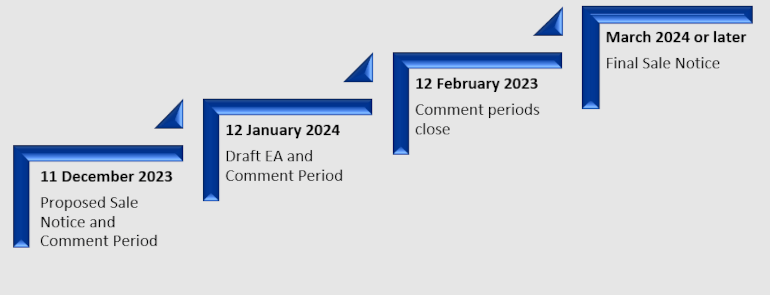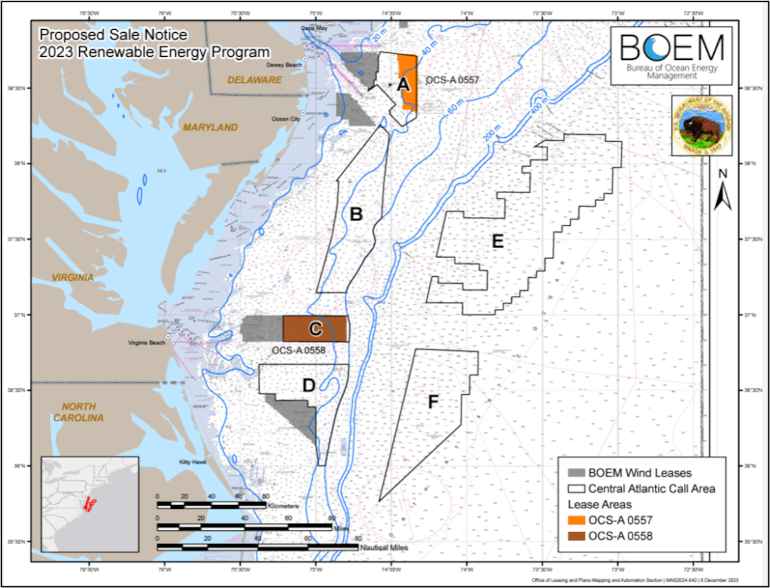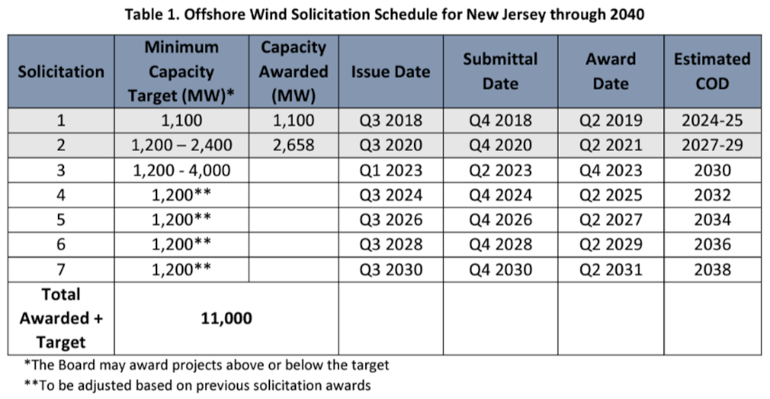Preparing for the Central Atlantic Auction: Examining lease areas for offshore wind
This piece presents a brief and high-level overview of the characteristics associated with each of the proposed lease areas being considered in the upcoming Bureau of Ocean Energy Management (BOEM) Central Atlantic auction.
BOEM identifies and leases areas for future development of offshore wind projects. This blog focuses on a high-level “compare and contrast” view of the lease areas within the Central Atlantic to aid developers and other interested stakeholders in better understanding each area as we approach the lease auction.

The recent and next steps toward the lease auction are:
- On 11 December 2023 BOEM published the Proposed Sale Notice (PSN) for a second lease auction for the Central Atlantic, opening a 60-day comment period. The PSN includes lease-specific terms and conditions, including communications plans, biological surveys, and reporting requirements.
- The Draft Environmental Assessment (EA) for lease and site assessment was published on 12 January 2024 opening a 30-day comment period. Both comment periods are now closed. The Final Sale Notice (FSN) will specify the auction date, final lease areas, the new auction type and rules, and the deadline to submit materials for the bidding credits. We can expect to see the FSN after BOEM reviews the comments submitted on the Draft EA and the PSN. The FSN will also include a list of the qualified bidders and the auction date.
- The offshore wind lease auction will be held at least 30 days after the FSN is published.

Figure 1: Map of Proposed Lease Areas A-2 (in orange) and C-1 (in brown)1
I opine on the advantages and disadvantages associated with the two lease areas, in comparison to other Atlantic leases, below.
Proposed Lease Area A-2
The northern proposed Lease Area (A-2) is within 11 nautical miles (NM) of three other offshore wind leases and is within 30 NM of the coasts of Maryland, Delaware, and New Jersey (referred to as coastal states herein). It encompasses 101 thousand acres in depths suitable for fixed foundations. The size is potentially large enough for phased construction of a single project development.

Concerning offtake and interconnection, the advantages of this site include: the three coastal states are actively pursuing offshore wind. New Jersey’s current solicitation schedule includes application opportunities every two years through 2030 (see Table 1)2. Maryland enacted a law in April 20233 establishing a new offshore wind goal of 8.5 gigawatts, a new procurement method through its Department of General Services, and a transmission planning study. These are in addition to other research and programs supported by the states. Delaware released its proposed procurement strategy4 in December, which included recommendations to authorize procurement and maintain flexibility concerning structure and partnerships with other states.
The lease area is relatively close to shore, reducing the cost and complexity of an export cable, its installation, and obtaining the necessary environmental permits. The disadvantages include locating a permittable cable route offshore and grid interconnection onshore, which we understand to be challenging based on the experiences of current leaseholders in the region.
From a permitting perspective, the advantages of being proximate to existing leases poses fewer uncertainties. These advantages range from having a known list of interested entities and stakeholders, existing baseline studies that enables an understanding of the potential impacts of concern, the ability to anticipate a large portion of the required environmental mitigations, and greater maturity in the coastal states’ engagement.
The uncertainties related to setbacks from the proposed marine fairways will be resolved if the recently proposed rule is adopted for the Shipping Safety Fairways Along the Atlantic Coast5. As a result, the auction winner of both Central Atlantic proposed lease areas can begin designing a layout with a predictable set of maritime-related constraints and have reasonable confidence that a conforming layout can be approved by BOEM.
Proposed Lease Area C-1
Lease Area C-1, the southern proposed lease area, is 37 NM from the coast of Virginia and directly adjacent to an existing offshore wind lease. The lease area encompasses nearly 177 thousand acres, which is potentially large enough for two projects, which is significantly larger than proposed Lease Area A-1
Concerning offtake and interconnection, the current approach taken by the state of Virginia is for utility-ownership of an offshore wind project. This contrasts with the model utilized by other states which allow ownership by a third-party developer and purchase of the power by a utility. Effectively, a change in state law would be required to allow the alternative third-party approach, but this is not anticipated in the current legislative session.6
Regarding permitting, a location proximate to existing leases poses fewer uncertainties than are experienced by many of the other leaseholders, similar to proposed Lease Area A-2.
Also similar to the northern lease area, the possibility is remote for setbacks to be required that would reduce the buildable area adjacent to U.S. Coast Guard’s proposed marine traffic fairways.
A unique potential constraint for this lease area is associated with marine traffic; BOEM is currently requesting comments on the need for a non-buildable buffer between proposed Lease Area C-1 and the adjacent lease. Such a buffer could be a suggested mitigation coming from the U.S. Coast Guard initiated by a potential concern for safe transit through adjacent leases when the layouts do not align.
Conclusions
The advantages and disadvantages are similar for the two lease areas, except for the very important topic of obtaining an offtake agreement. Most developers pace their development spend and schedule in line with their expected ability to sign an offtake agreement prior to start of construction. The current Virginia requirements lend themselves to a leaseholder who desires a longer development lead time or a partnership with the Virginia utility.
1 BOEM, 2024, Commercial Wind Lease Issuance and Site Assessment Activities on the Atlantic Outer Continental Shelf of the Central Atlantic, U.S. Department of the Interior, Bureau of Ocean Energy Management, OCS EIS/EA BOEM-2024-003, January 2024.
2 NJBPU, 2021. New Jersey Offshore Wind Third Solicitation: Solicitation Guidance Document - Application Submission for Proposed Offshore Wind Facilities, New Jersey Board of Public Utilities, 6 March 2023.
3 State of Maryland SB 781/HB793. Offshore Wind Energy - State Goals and Procurement (Promoting Offshore Wind Energy Resources Act.
4 DE DNREC, 2023. Proposed Offshore Wind Procurement Strategy for Delaware, DNREC Division of Climate, Coastal and Energy, Synapse Energy Economics, and Zooid Energy, 29 December 2023.
5 USCG, 2024. Shipping Safety Fairways Along the Atlantic Coast, Department of Homeland Security, United States Coast Guard, USCG-2019-0279-0032, 18 January 2024.
3/11/2024 2:00:00 PM
